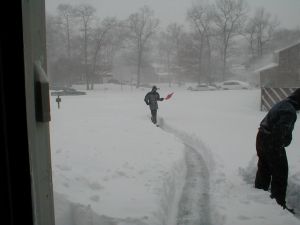
Winter is harsh and cold weather moving can make a difficult job even worse, especially if you are moving. Between the snow and freezing temperatures, home owners have to find the best way move without causing too much stress. While hiring a professional moving company like Men on the Move can help, there are few things you should know to help your winter move along.

On moving day, you need to remember you hired a moving company on moving day not a snow removal company. Moving companies will not clear the snow for your move. So, before they arrive, people need clear the driveway, walkway, sidewalks, back decks, and basement walkouts. Leaving snow and ice covering these areas are potential hazards that can injure the movers or others. That is why it’s important the pathways a clear for the moving process.
For a homeowner, there are few things you need to prepare for the movers. First of all, you need to make sure you have a friend or family member playing doorman for the movers. You wouldn’t want a moving technician carrying your expensive flat screen TV while trying to open a door. If you aren’t against a little cold, you could also keep the front door open.
Protecting your floors and carpet from winter sludge and mud should be a priority. Typically for an additional fee, the moving company will lay plastic carpet protector along the main walkways of the home before the moving begins. There are logistical, liability, and safety concerns associated with movers wearing any type of disposable shoe covers. Check with your moving company before the scheduled moving day.
Another thing you should keep on an eye on is your electronics. Extreme temperature changes can cause condensation build up on the high tech circuits. Consumer electronic items such as computers, laptops, DVD players, TVs, stereos are subject to this. It is best for your electronics to acclimate to room temperature for at least 24 hours before plugging everything in and setting it up.
If you are moving appliances into your home, you need to make sure it ready.
Washers
Even though your washer should be drained before moving it, the washer will always maintain a little water. Components like the mixer valve, pump housing and internal hose areas may have moisture. Using your washer while water is frozen in these components can result in damage to belts, hoses and other internal parts of the washer. Your washer should only be operated at a temperature of above 60°F.
Dryers
Like most things when subject to freezing temperatures, igniters and heating elements in the dryer can become brittle. Operating the dryer will cause a sudden temperature change and may damage internal parts. Your dryer should only be operated at a temperature of above 60°F.
Refrigerators
A refrigerator may be plugged in for use the day of the move, but the ice maker should not be connected to the water supply for at least 24 hours. Moisture in the solenoid valve, supply lines and cold-water reservoir may be frozen. This will hinder the normal operation of the icemaker. If the cold water reservoir was not drained before the move started, it could be frozen solid causing hairline cracks in the water reservoir. It is very important to let all components of the ice maker system reach operating temperature first. Then a thorough check can be completed after hooking up the water supply.
Open doors and lower thermostat settings are typical moving day phenomenon. So remember to think of your pets and indoor plants as well when moving in winter.
Posted In: Moving Tips
Tags: Cold Weather, Moving Appliances, Winter Moving